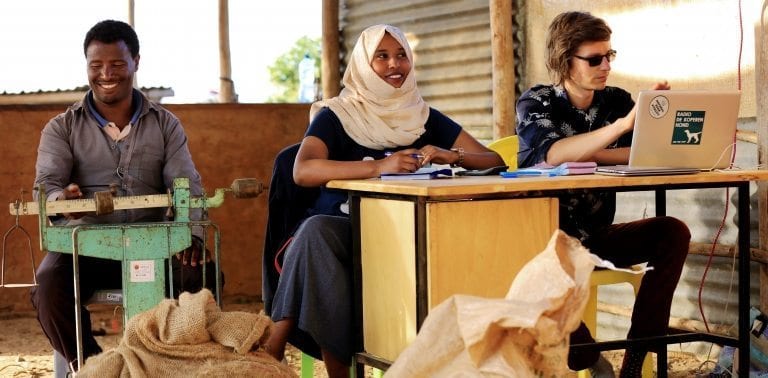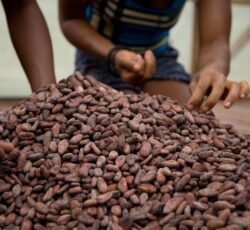Fairfood <3 Blockchain
If you follow our work, by now you’ll know about our love for blockchain. Last year we were the first in the Netherlands (and one of the first worldwide) to put a food supply chain on the blockchain. As we speak, we are doing the same with Ethiopian coffee beans, together with our partner FairChain Foundation. Time for a little reflection. What is it we see in blockchain?
Our blockchain specialist Marten van Gils already formulated an answer to this question with this more elaborate white paper. We can imagine not everyone has the time to read all of that, so we’ll summarize here.
The issues
Did you know that in the coming 40 years we’ll consume as much food as we did in the last 800 years? The supply chains of our food are rapidly becoming more complicated to manage the increasing flow of raw materials and goods needed to feed the ever growing world population. The result: less transparency, leaving room for abuse and fraud. Another problem lies in inefficiency – the Amazon rainforest and its inhabitants, for instance, had to make way for food production, while roughly one third of the food produced globally is wasted. Then there are the people behind our food – 70% of our food is being produced by small-holder farmers, the majority of whom live on or below the poverty line.
What blockchain can offer, is transparency in a supply chain that is currently very much a blurred one.
The technology
In comes blockchain. Let’s get technical for a bit: a blockchain is a distributed database that consists of a continuously growing list of records, called blocks, which are linked and secured using cryptography. Every record could be considered a ‘block’. A block can be a transaction – John gave Mary X euro – but can also consist out of pieces of computer code. This allows for information and processes to be recorded on the blockchain.
Blockchains have a few applications that particularly have us feeling excited, because they are extremely relevant to our food system. Digital identification can increase the traceability of food. Think of it as a digital product passport that can show you exactly where a product comes from. Then there are the smart contracts: sets of business rules written in code onto the blockchain. Being self-enforcing, smart contracts can help automate and govern food production processes efficiently. With digital currencies, value can be transferred and stored via the internet in a secure and cheaply manner. Finally, there is the distributed storage. Various actors in the supply chains currently use different systems to store their data. Distributed storage allows them to safely store and share their data. A step further: they can meet the increasing demand for transparency, without having to fear that certain data will be made public.

The promise
Sounds good, right? We couldn’t agree more. What these applications together can offer, is transparency in a supply chain that is currently very much a blurred one. Another reason to get excited: because there is no central authority – all parties involved have access to the blockchain – certain actors will be taken power off their hands that is currently often being misused.
What makes us very happy, is the efficiency that blockchain can bring. Blockchain can streamline important administrative processes – invoicing, payments, stock – thus saving costs. Also, actors who do add costs but don’t add value can easily be identified and taken out of the chain. Dare to fantasize a little: without the need to pay more as a consumer, more money can end up going to the now often underpaid farmer.
With blockchain, the people behind our food become active players in a system they were previously marginalized in.
The farmer
The inclusiveness that blockchain can bring, is of course the ultimate promise. With blockchain, the people behind our food become active players in a system they were previously marginalized in. Hundreds of millions of small-scale farmers would gain a stronger position. Being at the beginning of their food supply (block)chains, farmers not only control the physical products they grow, but also the – valuable – digital products they create on the blockchain. Unnecessary middlemen can be bypassed and the farmers get a better negotiating position.
Fairfood is here for the people behind our food, but of course it is not our intention that anyone else will make any unnecessary sacrifices. Fortunately, blockchain offers a little something for all of us. For producers and retailers the system offers interesting opportunities when it comes to efficiency – because these parties receive more reliable information about other actors in the chain, unnecessary and inefficient steps can be avoided. For you as a consumer there’s also a nice little something to be gained: the digital passports that blockchain is for everything you buy in the supermarket, tell you exactly what the history of that product is. This way you can immediately see whether that product fits your needs. Is it organic? Vegan? Sustainable?
That is what Fairfood strives for: inclusive blockchains for food.
Fairfood
That beautiful image we painted above, will of course only be realized if blockchains are indeed inclusive. That is what Fairfood strives for: inclusive blockchains for food. We want to show you – the consumer – the potential of this beautiful technology, and in the meantime get the industry on board. With continuous research, we will build and share our knowledge about this new technology. This way our team’s knowledge base will grow and be made available to others. In our projects, we will partner with businesses and other organizations to develop and apply blockchains to more, larger and more complex supply chains, to form a tried and tested idea of how blockchains for food should ideally look. Together we can make this dream come true.

